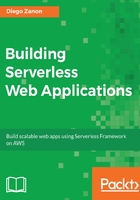
Continuous delivery
Serverless is based on breaking a big project into dozens of packages, each one represented by a top-level function that handles requests. Deploying a new version of a function means uploading a ZIP file to replace the previous one and updating the event configuration that specifies how this function can be triggered.
Executing this task manually, for dozens of functions, is an exhausting task. Automation is a must-have feature when working in a serverless project. In this book, we'll use the Serverless Framework that helps developers manage and organize solutions, making a deployment task as simple as executing a one-line command. With automation, continuous delivery is a feature that brings many benefits, such as the ability to deploy at any time, short development cycles, and easier rollbacks.
Another related benefit when the deployment is automated is the creation of different environments. You can create a new test environment, which is an exact duplicate of the development environment, using simple commands. The ability to replicate the environment is very important for building acceptance tests and to progress from deployment to production.